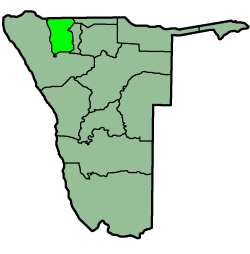Omusati Region
Omusati Region | |
|---|---|
 Location of the Omusati Region in Namibia | |
| Country | Namibia |
| Capital | Outapi |
| Government | |
| • Governor | Erkki Endjala[1] |
| Area | |
| • Total | 26,551 km2 (10,251 sq mi) |
| Population (2011)[3] | |
| • Total | 242,900 |
| • Density | 9.1/km2 (24/sq mi) |
| Time zone | South African Standard Time: UTC+1 |
Omusati region is one of the fourteen regions of Namibia, its capital is Outapi. The region's name Omusati, comes from the Oshiwamo word 'omusati' which means 'Mopane'. Mopani tree is the dominant species in the region; the Makalani palms decrease rapidly westwards from the border with Oshana region. The change in vegetation type reflects ecological conditions forming a natural boundary between the two regions.
The northern part of this region is far more densely populated than the south, where the grazing is of poor quality and the water generally saline. This is predominantly an agricultural region in which mahangu is cultivated successfully. With intensive fertilisation and tilling of the soil, self-sufficiency should be attainable. A canal carries water from the Ruacana river to Oshakati, passing through Outapi. Water from this canal has been used to irrigate a large, government-run farm at Etunda where crops from maize to watermelon to bananas are grown. Apart from the government run-farm, people living alongside the canal have taken full advantage of the abundant water that the canal provide, and vegetable gardens can be seen in the fields alongside the canal. Non-agricultural employment opportunities will need to be created, however. The electrical network is expanding; while the rural areas may still lack electricity, towns including Outapi, Ruacana, Tsandi, Oshikuku, and Okahao all have electricity.
The region is traversed by a high standard trunk road which provides a direct link to adjacent regions and the rest of the country. Although passenger and freight transport along this route is easy, the rest of this road network, in common with all the communal areas of northern Namibia, is of poor quality. Okahao and Outapi both have small hospitals, and a network of clinics provides basic services. The provision of schools is also inadequate and improvement in the position is expected.
The region is home to the world renowned Ruacana Falls. The waterfall is 120 meters (390 ft) high and 700 meters (2,300 ft) wide in full flood and It is among the largest waterfalls in Africa, both by volume and width. Omusati is also home to the Omugulugombashe Heritage Site, where Namibian struggle for independence started in 1966.
In the north, Omusati borders the Cunene Province of Angola. Domestically, it borders the following regions:
Politics
The governor of Omusati is Erkki Endjala.[1] The region comprises twelve constituencies:
Electorally, Omusati region is consistently dominated by the South West Africa People's Organization (SWAPO). For instance, Omusati voters selected SWAPO with 97.68% of their votes in the 2004 parliamentary election,[4] and again with 98% in the 2014 election. The 2015 local and regional elections saw SWAPO win uncontested eight of the twelve Omusati constituencies, and two of the five towns.[5] The remaining four constituencies SWAPO won by a landslide, with results ranging from 89% (Ruacana) to 98% (Ogongo).[6]
Economy and infrastructure
Only 17% of households in Omusati have access to improved sanitation (toilet facilities).[7] According to the 2012 Namibia Labour Force Survey, unemployment in the Region is 28.9%.[8] Omusati has 274 schools with a total of 86,365 pupils.[9]
References
- ^ a b "President announces governors". The Namibian. 10 April 2015.
- ^ "Namibia's Population by Region". Election Watch (1). Institute for Public Policy Research: 3. 2013.
- ^ Smit, Nico (12 April 2012). "Namibia's population hits 2,1 million". The Namibian.
- ^ Election Update 2004 Archived 2008-12-03 at the Wayback Machine Namibia
- ^ "Opposition parties are mosquitoes, says Kawana". The Namibian. 26 October 2015.
- ^ "Regional Council Election Results 2015". Electoral Commission of Namibia. 3 December 2015. p. 17. Archived from the original on 8 December 2015.
{{cite web}}: Unknown parameter|deadurl=ignored (|url-status=suggested) (help) - ^ Tjihenuna, Theresia (2 April 2014). "More than 1 million Namibians defecate in open". The Namibian.
- ^ Duddy, Jo Maré (11 April 2013). "Unemployment rate still alarmingly high". The Namibian. Archived from the original on 14 April 2013.
{{cite news}}: Unknown parameter|deadurl=ignored (|url-status=suggested) (help) - ^ Miyanicwe, Clemans; Kahiurika, Ndanki (27 November 2013). "School counsellors overstretched". The Namibian. p. 1.
